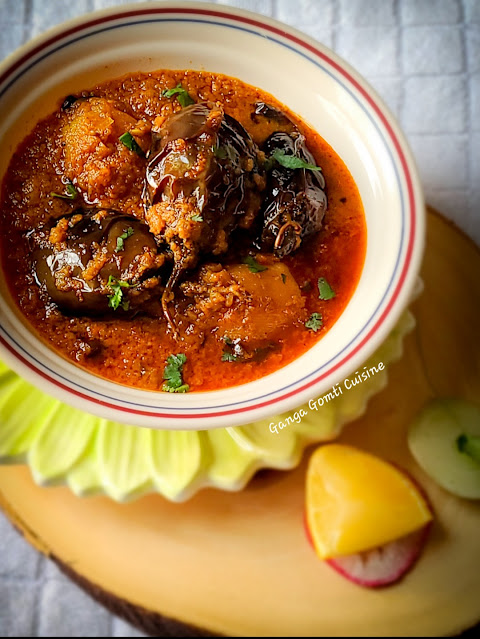Aalu Baingan Rasedar
Aalu Baingan Rasedar
Baingan or Brinjal/Eggplant is basically a fruit or herb, which is commonly used as vegetable!
Brinjal was first domesticated in India. The Persians then introduced it to Africa from India while the Arabs introduced it to Spain. It presumably spread from Spain to the rest of Europe. Today, many varieties of brinjal can be found growing throughout the warmer parts of the world.
Brinjal is classified as a herb because of its non-woody stem. In traditional Chinese medicine, all parts of the plant are used to stop intestinal bleeding. The fruit of the plant is also used as an antidote for mushroom poisoning. In Indochina, parts of the plant are used as a purgative. In traditional Malay medicine, the ashes of the fruit are used in dry, hot poultices to treat haemorrhoids. To treat ulcers, the root is pounded and applied inside the nostrils. The Amboinese take the juice of the root of a wild variety of the plant to ease a difficult labour. Arabs believe that the fruit has high “heating” properties that in turn cause melancholia and madness. For this reason, Malay and Indian women do not consume brinjal for the first 40 days after giving birth.
This Aalu Baingan Rasedar sabzi is delicious North Indian gravy which can be enjoyed with chapatis and rice both.
Ingredients:- Small brinjal/Indian eggplant-4
- Baby potatoes-3
- Tomato-1 large
- Onion-2 medium
- Garlic-4 cloves
- Green chilli-2
- Panchfodan spices for tadka
- Hing-1 pinch
- Red chilli powder-1 tsp.
- Turmeric powder-1/4 tsp.
- Garam masala powder-1/2 tsp.
- Roasted coriander-1/2 tsp. coarsely pounded
- Roasted cumin powder-1/4 tsp.
- Whole coriander-1/2 tsp.
- Salt
- Curd-2 tsp.
- Coriander leaves-5-6 stems
Procedure:
- Peel the potatoes and slit in the middle.
- Make a plus shaped cut in brinjals without chopping the stem.
- In a kadai, add 2 tbsp. of oil (Mustard oil) and when hot, add these veggies and shallow fry.
- In a blender, make a paste of onion, garlic, green chilli, coriander leaves and tomato.
- Now heat a pot, add oil for masala.
- When oil is hot, add whole coriander leaves and panchphoran masala and hing.
- Immediately add half spoon finely chopped onion and then add blended masala and all the powdered masalas except garam masala.
- At this point, add curd also, cover and cook till oil starts separating.
- Now add fried potato and brinjal and without stirring, just cover the lid and keep cooking on slow flame.
- When potato and brinjal are soft and properly cooked, add water for gravy, consistency should be medium thick.
- Give it a boil, add garam masala and garnish with coriander leaves.
- Serve hot, enjoy!

Baingan or Brinjal/Eggplant is basically a fruit or herb, which is commonly used as vegetable!
Brinjal was first domesticated in India. The Persians then introduced it to Africa from India while the Arabs introduced it to Spain. It presumably spread from Spain to the rest of Europe. Today, many varieties of brinjal can be found growing throughout the warmer parts of the world.
Brinjal is classified as a herb because of its non-woody stem. In traditional Chinese medicine, all parts of the plant are used to stop intestinal bleeding. The fruit of the plant is also used as an antidote for mushroom poisoning. In Indochina, parts of the plant are used as a purgative. In traditional Malay medicine, the ashes of the fruit are used in dry, hot poultices to treat haemorrhoids. To treat ulcers, the root is pounded and applied inside the nostrils. The Amboinese take the juice of the root of a wild variety of the plant to ease a difficult labour. Arabs believe that the fruit has high “heating” properties that in turn cause melancholia and madness. For this reason, Malay and Indian women do not consume brinjal for the first 40 days after giving birth.
This Aalu Baingan Rasedar sabzi is delicious North Indian gravy which can be enjoyed with chapatis and rice both.
Ingredients:
- Small brinjal/Indian eggplant-4
- Baby potatoes-3
- Tomato-1 large
- Onion-2 medium
- Garlic-4 cloves
- Green chilli-2
- Panchfodan spices for tadka
- Hing-1 pinch
- Red chilli powder-1 tsp.
- Turmeric powder-1/4 tsp.
- Garam masala powder-1/2 tsp.
- Roasted coriander-1/2 tsp. coarsely pounded
- Roasted cumin powder-1/4 tsp.
- Whole coriander-1/2 tsp.
- Salt
- Curd-2 tsp.
- Coriander leaves-5-6 stems
Procedure:
- Peel the potatoes and slit in the middle.
- Make a plus shaped cut in brinjals without chopping the stem.
- In a kadai, add 2 tbsp. of oil (Mustard oil) and when hot, add these veggies and shallow fry.
- In a blender, make a paste of onion, garlic, green chilli, coriander leaves and tomato.
- Now heat a pot, add oil for masala.
- When oil is hot, add whole coriander leaves and panchphoran masala and hing.
- Immediately add half spoon finely chopped onion and then add blended masala and all the powdered masalas except garam masala.
- At this point, add curd also, cover and cook till oil starts separating.
- Now add fried potato and brinjal and without stirring, just cover the lid and keep cooking on slow flame.
- When potato and brinjal are soft and properly cooked, add water for gravy, consistency should be medium thick.
- Give it a boil, add garam masala and garnish with coriander leaves.
- Serve hot, enjoy!





Comments
Post a Comment